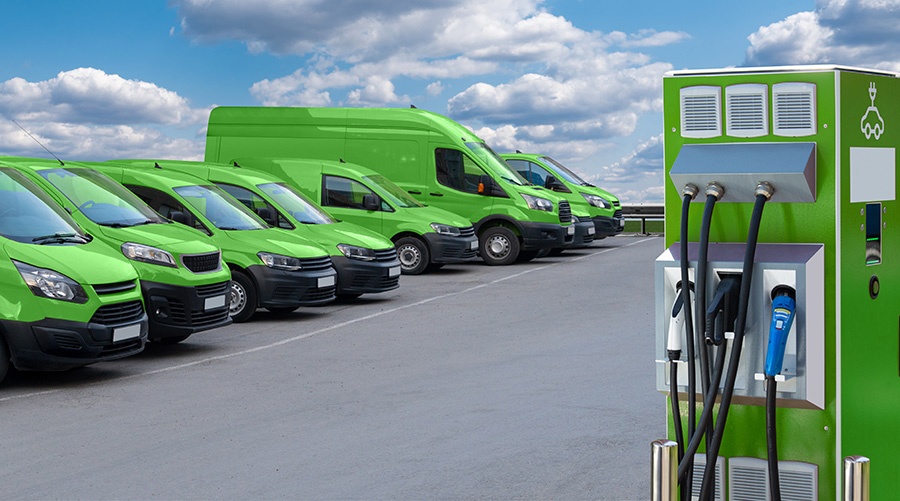
According to Germany’s market research firm Statista, the transport sector now accounts for 20 per cent of global CO₂ emissions and is the second-largest carbon-polluting sector worldwide. Additionally, in Vietnam’s action programme on the green energy transition, the transport sector is expected to contribute to a 0.89 per cent reduction in greenhouse gas (GHG) emissions using domestic resources or 2.23 per cent with international support by 2030, and achieve net-zero emissions by 2050.
Looking within the transport sector, it does not take rocket scientists to see that commercial vehicles contribute considerably more to carbon emissions than those used for individual purposes. Research from the International Council on Clean Transportation shows that the use of electric trucks and buses could reduce carbon emissions by 37 per cent and PM2.5 emissions by 94 per cent in 2030, when compared to a business-as-usual scenario.
Yet, policy discussions about electric vehicles (EVs) often neglect commercial vehicles. The commercial transport industry, comprising trucks, buses, taxis, and delivery vehicles, constitutes a significant portion of Vietnam’s vehicle fleet and fuel consumption. Electrifying this sector can have a far greater impact on reducing pollution and dependence on fossil fuels than the passenger car sector.
The adoption of electric transport vehicles can lead to a significant reduction in GHG emissions, improvement in air quality, and enhancement of energy security in Vietnam. These benefits are in line with the country’s commitment to achieve net-zero emissions by 2050 under COP26.
The EV market
The EV market size in Vietnam increased at a compound annual growth rate of 22.9 per cent from 2020 to 2025, according to India’s consulting firm 6Wresearch. This indicates a growing demand and awareness for green mobility among consumers and businesses. The market is dominated by two-wheelers, which account for more than 90 per cent of the total EV vehicle sales. However, there is also a growing potential for electric passenger cars and buses, especially with the recent launch of new passenger car models by domestic and foreign manufacturers such as VinFast, TMT Motors, KIA, Porsche, BYD, and Mercedes-Benz.
Developing electric cargo trucks and large passenger vehicles presents numerous challenges. Firstly, the high cost of heavy-duty lithium-ion batteries required to power these vehicles can significantly drive up the cost of electric trucks compared to diesel-powered ones. However, over time, the lower cost of electricity compared to fossil fuel and other sustainability-related incentives may offset the initial investment.
Second is the maintenance and reliability. While EVs are generally more reliable than gas thanks to their electric powertrain, they can be as expensive or even more expensive to maintain than traditional vehicles. Replacing a lithium-ion battery, for example, can be a costly endeavour. VinFast’s battery rental initiative presents a model that has the potential for wider applications in the industry.
In a press conference in Detroit last year, Craig Westbrook, deputy CEO of VinFast US, responded to reporters’ questions about developing an electric pick-up truck, saying the manufacturer would consider such an option to expand its product line-up as it would fit with the company’s manufacturing platform. This might also be viewed as a tactic to penetrate the US car market, where the pickup truck segment is the world’s largest.
At home, VinBus’ e-buses were first introduced to cater to the transportation requirements of Vinhomes inhabitants and to link the major Vinhomes residential areas, but they are becoming more popular in both Hanoi and Ho Chi Minh City. In April, VinFast partnered with local ride-hailing company Be to launch Xanh SM, the first fully electrified taxi, as a strategic move to introduce their electric vehicles to a wider audience and boost sales. VinFast has also recently disclosed the launch of a fresh e-bus route that connects Vinhomes Ocean Park residential triangle to Noi Bai International Airport, and it’s just a question of time before more routes become available.
Nguyen Trung Kien, COO of TMT Motors, said his company recognises that this is a strong future trend and has plans to supply EVs to meet the demand in this segment in the next few years. Specifically, TMT Motors has an exciting project in the works that involves collaborating with an international transport and logistics company in Vietnam to provide tractors and van trucks to customers by in 2024.
Some big-name customers of the carriers, such as Adidas and Nike, have requested a transition to new energy engines to align with their global sustainability policies, making electric engines the optimal solution. When this project kicks off, TMT Motors will be the first company in Vietnam to provide EVs for the commercial vehicle segment.

Charging Infrastructure
The lack of infrastructure for charging EVs, especially large cargo trucks and passenger vehicles, is a significant hurdle to their widespread adoption. Industry experts suggest that early developments in this area will be privately funded and maintained. A recent survey conducted by VERO’s mobility practice among respondents aged 18-54 revealed that 90 per cent of those who said no to the prospect of buying an e-car cited concern that the current network of charging stations was insufficient.
Vingroup’s chairman Pham Nhat Vuong announced at the company’s annual shareholders’ meeting in May that the group is investing $500-700 million to develop charging infrastructure across the country. He also made clear that Vingroup did not intend to share this infrastructure with competitors for the next 10 years. While VinFast’s efforts to date are admired, it is essential for industry stakeholders to recognise that for the EV market to grow to its full potential, the participation of other manufacturers will be critical as the charging infrastructure is a primary barrier to growth in the foreseeable future.
Meanwhile, two startups called EBOOST and CHARGE+ are making strides in Vietnam’s EV market. EBOOST, funded by the Southeast Asia Clean Energy Facility Fund, had already installed over 700 charging points throughout the country by the end of 2022.
CHARGE+ has partnered with CapitaLand and aims to install 5,000 charging points by 2030. However, despite their efforts, there is still a need for much more charging infrastructure to support the growth of EVs in Vietnam’s rapidly expanding automobile industry.
Policy changes needed
The Vietnamese government has introduced a number of tax incentives to boost green mobility, including a three-year exemption of registration fee for electric car owners starting from March 2022, and a reduction of the special consumption tax rate to just 1-3 per cent until the end of February 2027.
Compared to petrol-fuelled cars with the same seating capacity, the registration fee for electric cars will be just 50 per cent for the next two years, making owning an electric car more accessible for many.
If there is one thing Vietnam is not short of, it is action plans. There is abundant empirical evidence to suggest that the major obstacle to change is often not the lack of action plans, it is the inability to execute them and enforce legislation.
While the existing incentives will undoubtedly boost the demand for EVs in the country, more supportive concrete policies are needed to bring the July 2022 green energy transition action plan to life by effectively tackling the challenges of the commercial transport sector.
In May this year, the Ministry of Transport (MoT) proposed EV-supporting policies, which included a subsidy of $1,000 per EV, similar to policies in Thailand, the United States, and China. This proposal sparked hope for EV industry advocates. However, the Ministry of Finance later rejected the proposal, citing concerns that it was not suitable for Vietnam, as car buyers were viewed as high-income earners.
While this egalitarian mindset is understandable, the MoT could still pursue policy changes to boost greening in the commercial transport sector, since commercial vehicles are means of production. Other supporting policies worth considering include tax breaks or lower revenue tax rates for transportation companies using EVs, and incentivising investments in charging stations as well as public and private funding for research and development in battery and charging technology, which, in return, would also enhance the country’s positioning in the global vehicle industry.
A shining example of a country that has electrified its mobility so effectively is Norway, where a vast majority of its power comes from renewable sources, the government has introduced clear policies to make EVs affordable to its population.
What countries like Vietnam could learn from Norway is that, in addition to giving tax exemptions to EVs, the government also makes internal combustion engine vehicles more expensive by increasing VAT to 25 per cent and carbon tax to nearly 20 per cent. Since EVs are more expensive than traditional vehicles to manufacture, the Norwegian leadership’s view is that the more expensive the vehicle, the bigger the government subsidy.
Elsewhere, US President Joe Biden recently announced new standards for an initiative aimed at building a national network of 500,000 EV charging stations by 2030. Through this initiative, the US government hopes to establish a foundation for states to build charging station projects that are easily accessible to all drivers, irrespective of their location, EV brand, or tolling company. In line with this, the White House has released a plan to allocate $5 billion to states to fund EV chargers for the next five years. To fulfil its net-zero commitments by the agreed deadline, Vietnam would benefit from a strong focus on prioritising policies to boost the development of EVs in the transport sector.
In addition to tax exemptions and reductions for EV manufacturers and fleet buyers, it is important to consider setting emission standards or quotas for commercial vehicles, supporting research and development of EV technologies, promoting further investment in charging infrastructure, and educating the public on the benefits of commercial EVs as well as driving behaviour change. These measures can reduce upfront costs and increase accessibility.
Without proper policies and well-developed infrastructure for all players, it would be challenging to achieve the net-zero commitments by the agreed timeline if left to its natural course.
Arthur Do




